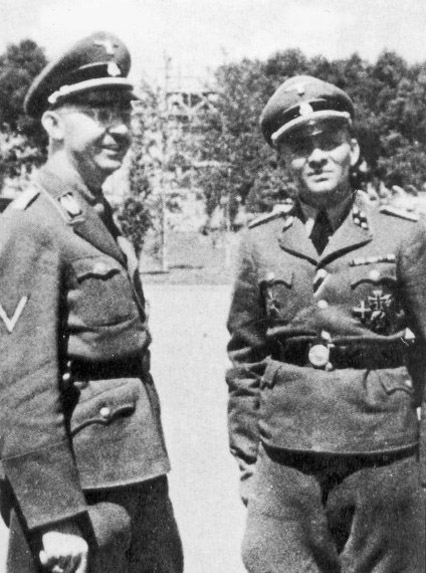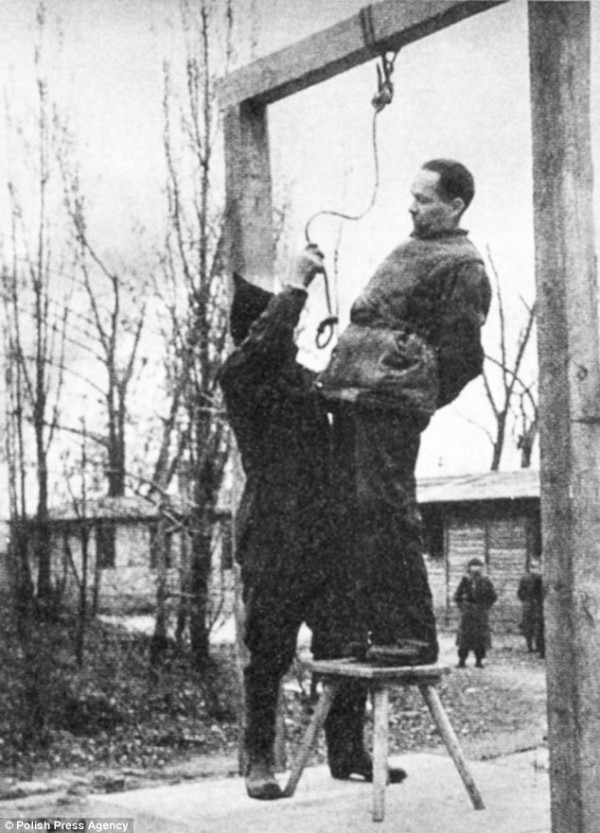- Hanns Alexander fled Germany shortly before Kristallnacht
- He joined the British Army and part of a team hunting senior Nazis
- Mr Alexander helped capture Auschwitz commandant Rudolf Hoss
A German-born Jewish refugee who served in the British Army during World War II has been unveiled as one of the leading investigators responsible for the capture of one of the worst Nazi criminals of the Holocaust.
Throughout his life in Britain, Hanns Alexander never spoke of his involvement in the hunt for Auschwitz commander Rudolph Höss, and the truth was not unveiled until after his death.
In 1946 he played a crucial role in bringing Höss to justice, a man responsible for killing millions of Jewish men, women and children.
Rudolph Höss was not only in charge of the deadliest of the Holocaust concentration camps, he was also the mastermind behind the use of Zyklon B to commit mass killings of, mainly Jewish, prisoners.
Mr Alexander’s story was uncovered by his great-nephew at the war hero’s funeral in 2006.
During a eulogy, Mr Alexander’s nephews spoke of his past as a Nazi hunter and Thomas Harding, whose grandmother was Mr Alexander’s sister, began to investigate his past.
Hanns Alexander fled from Berlin to London in 1936 after his father, already in England, heard rumours of what was about to take place in their native Germany.
When Britain declared war on Germany in 1939, 22-year-old Hanns and his twin brother Paul volunteer for the British Army and were placed with the Auxiliary Military Pioneer Corps, a unit of refugees who wanted to fight the Nazis.

Nazi hunter: Hanns Alexander, a Jewish refugee serving in the British Army, captured Rudolph Hoss
In 1945, having taken part in the D-Day landings in Normandy and witnessing the liberation of Bergen Belsen concentration camp, Hanns Alexander was chosen to take part in a 12-strong team, tasked with tracking down Nazi war criminals.
As the team rounded up the Bergen Belsen guards and administrators, interpreter Hanns became central in the interrogations and uncovers Rudolph Höss’s role in the Holocaust.
Hanns Alexander then began his hunt for Höss, knowing that the former Auschwitz Kommendant would hold the key information to the workings of the Nazi atrocities committed against his people.

The fall of a Nazi criminal: Rudolf Höss, pictured with Heinrich Himmler during an inspection of Auschwitz ,

battered and bruised following his arrested by the British, in March 1946
After the fall of Auschwitz, Höss and his family had fled towards the Danish border. British intelligence had tracked them down to the Flensburg area, where Höss’s wife Hedwig and their children lived in an old sugar factory.
Having managed to intercept a letter from Hedwig proving that she knew where her husband was hiding, she had been taken in for questioning.
Hanns arrived on March 7, 1946 and begin to interrogate Mrs Höss. She would not budge. But neither would Hanns Alexander.
Hanns and members of his team brought in Höss’s oldest son Klaus and threatened Hedwig with deporting him to Siberia.
Ten minutes later, Hedwig had written down the location and new alias of her husband, who was living at a farm under the name Franz Lang.
Rudolf Höss was arrested on March 11, 1946. Hanns Alexander and his men dragged him out of hiding and beat him until he gave up his true identity.
Höss stood trial at Nuremberg in April and was subsequently handed over to Polish authorities on 25 May 1946, where he stood trial accused of murdering three million people.
Höss was sentenced to death on 2 April 1947 and was hanged immediately adjacent to the crematorium of the former Auschwitz I concentration camp on April 16.
Captain Hanns Alexander never returned to Germany, and died in London in 2006, aged 89.



Leave a reply